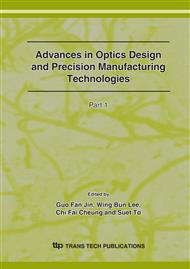p.961
p.967
p.973
p.980
p.986
p.992
p.998
p.1003
p.1009
An Empirical Approach for Identification of Sources of Machining Errors in Ultra-Precision Raster Milling
Abstract:
Ultra-precision raster milling is one of the most significant techniques for the fabrication of high precision components with the surface roughness less than 10nm and form errors less than 0.2 um, without the need for any subsequent polishing. However, no matter how well a machine may be designed, there is a limit to the accuracy that can be achieved. This paper studies the machining errors caused by the diamond tool and the axis motions using Freeform 705G. With an empirical approach, the error sources are separated based on their effects on the surface finish. The main source leading to poor surface finish is identified. This establishes a basis for subsequent error compensation and equipment maintenance.
Info:
Periodical:
Pages:
986-991
Citation:
Online since:
December 2007
Authors:
Price:
Сopyright:
© 2008 Trans Tech Publications Ltd. All Rights Reserved
Share:
Citation:


